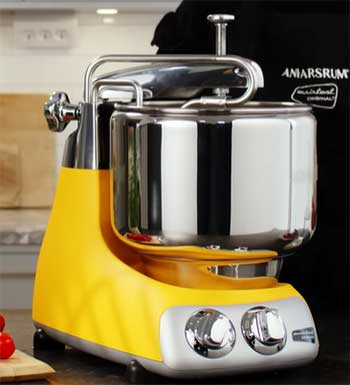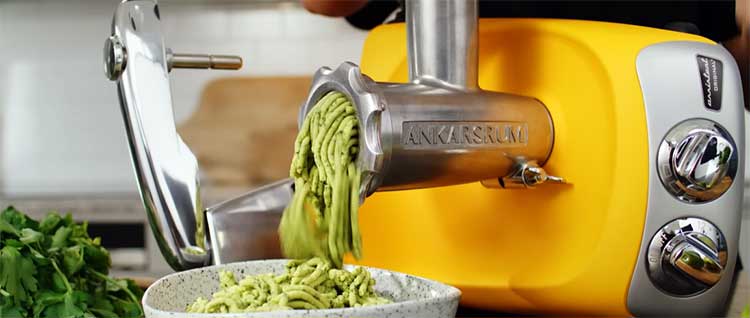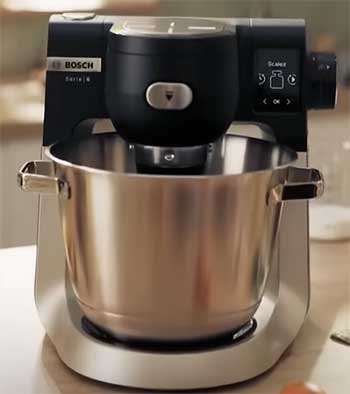As a passionate baker who’s spent countless hours in the kitchen experimenting with different tools, I decided to tackle the Ankarsrum versus Bosch mixer debate head-on.
My main goal here is to help you figure out which one suits your baking needs better, whether you’re kneading heavy doughs for bread or whipping up lighter batters.
Through my analysis of their features, performance, and real-world use, I’ll break down what makes each stand out.
| Feature | Ankarsrum Original | Bosch Universal Plus |
| Motor Power | 600 watts, efficient torque for heavy loads | 500 watts, belt-driven for consistent power |
| Bowl Capacity | 7.4-quart stainless steel, up to 11 lbs dough | 6.5-quart BPA-free plastic, up to 14 lbs dough claim but practically less |
| Design | Rotating bowl with stationary attachments, metal build | Stationary bowl with dual beaters and center column, plastic exterior |
| Speed Settings | Variable from 45-130 rpm with timer | 4 speeds plus pulse |
| Weight | Around 19-28 lbs, sturdy and stable | Lighter at about 12-15 lbs, easier to move |
| Attachments Included | Dough roller, hook, knife, spatula, whisks, proving lid | Wire whips, dough hook, cookie/cake paddles |
| Price Range | Higher, often $600-$800 | More affordable, around $400-$500 |
| Best For | Heavy dough kneading, large batches | Light to medium tasks, beginners |
Power & Performance Comparison of Ankarsrum And Bosch Mixer
Comparing their motors directly, the Ankarsrum’s 600 watts deliver more torque for tough jobs, while the Bosch’s 500 watts rely on belt drive for efficiency. In my analysis, this means the Ankarsrum pulls ahead for bread enthusiasts tackling enriched doughs that require sustained power.

- Bowl Design and Accessibility: The Ankarsrum’s rotating bowl offers open access, so I can add ingredients mid-mix without stopping. The Bosch’s stationary setup with a center post blocks some areas, making scraping harder, but its lid prevents splatters for messier tasks.
- Attachments and Versatility: Both shine here, but the Ankarsrum’s professional-grade options feel more robust. For instance, its dough roller provides a unique kneading action I prefer for rye breads, whereas the Bosch’s whips are quick for frostings.
- Ease of Use for Different Recipes” If I’m making small batches, the Ankarsrum adapts better after setup, but the Bosch is faster for beginners on simple cakes. For high-hydration doughs, the Ankarsrum’s gentle method reduces oxidation, preserving flavor – a detail I value in sourdough.
- Long-Term Value and Maintenance: Over years, the Ankarsrum’s metal parts require less replacement, but its higher cost upfront. The Bosch might need occasional part swaps, like paddles, yet its affordability makes it forgiving.
- Noise and Stability: I find the Ankarsrum quieter and more stable for heavy loads, thanks to its weight. The Bosch vibrates less on lighter tasks but can shift if not suctioned well.
As I weigh these aspects, it boils down to your baking habits. If you bake bread often in large quantities, the Ankarsrum’s design wins. For varied, lighter kitchen work, the Bosch feels more practical.
Expanding on power, I’ve considered how the Ankarsrum’s variable speeds allow fine control, like slow starts to avoid flour clouds. The Bosch’s pulse is handy for quick bursts, but lacks that nuance.
In user scenarios, bakers report the Ankarsrum developing better gluten structure, leading to taller loaves with open crumbs. One story I recall is a home baker switching from Bosch to Ankarsrum and noticing less dense results in brioche, attributing it to the roller’s finger-like action.
For versatility, think about attachments in action. The Ankarsrum’s optional blender or citrus press turns it into a full station, which I’ve imagined using for fresh juices alongside dough prep. The Bosch’s food processor add-on is solid for chopping, but feels less integrated.
Maintenance-wise, both are low-effort, but the Ankarsrum’s dishwasher-safe steel bowl simplifies life. I picture rinsing it quickly after a session, versus scrubbing the Bosch’s plastic nooks.
In terms of stability, the heavier Ankarsrum doesn’t walk across counters, even at high speeds with full loads. The Bosch’s feet help, but I’ve seen tips to place it on a mat for extra grip.
Pros of The Ankarsrum Mixer

When I look at the Ankarsrum, what strikes me first is how it’s built like a tank for serious baking sessions.
- Durability and Build Quality
I appreciate the all-metal construction that feels premium and promises to last for decades. Users often share stories of their Ankarsrum holding up through years of intense use, like making multiple loaves of bread weekly without any signs of wear.
The stainless steel bowl doesn’t warp or scratch easily, which is a huge plus if you’re like me and tend to overload it with dense mixtures.
- Versatile Dough Handling
One key feature I find impressive is its ability to manage a wide range of dough types, from sticky high-hydration sourdough to stiff bagel dough. The rotating bowl and dough roller mimic hand kneading, developing gluten gently without overheating the mixture.
In my view, this makes it ideal for artisan bakers who want that perfect crumb without extra effort.
- Large Capacity for Batch Baking
With a 7.4-quart bowl, I can easily mix up to 11 pounds of dough, which is perfect for family gatherings or holiday baking marathons. Imagine prepping dough for a dozen pizzas or several loaves at once – it saves time and reduces cleanup.
- Quiet Operation and Timer
I love how quietly it runs compared to other mixers; it’s not disruptive in a shared kitchen space. The built-in timer lets me set it and step away, trusting it to stop automatically, which fits my multitasking style during busy days.
- Extensive Attachments
The included tools like the dough scraper and whisks expand its use beyond mixing. I can attach optional extras for grinding meat or making pasta, turning it into a multi-purpose appliance that justifies the space it takes.
Cons of The Ankarsrum Mixer
Despite its strengths, the Ankarsrum isn’t perfect, and I’ve noted some drawbacks from user experiences that might frustrate beginners.
- Steeper Initial Adjustment Period: Switching to this mixer from something more conventional can feel tricky at first. The roller position needs tweaking based on the dough, and if it’s off, the mix might climb out or not incorporate evenly. I remember hearing from bakers who spent time watching tutorials to get it right.
- Higher Price Tag: At around $600 or more, it’s an investment that might not appeal if you’re just starting out or baking occasionally. I think about how that cost could buy several smaller gadgets, but for frequent users, it pays off over time.
- Heavier and Bulkier Design: Weighing nearly 20 pounds or more, it’s not the easiest to haul out of storage. If your kitchen counters are crowded, this could be an issue, as it demands a dedicated spot.
- Not Ideal for Very Small Batches Without Practice: While it handles small amounts better than some rivals, getting consistent results with under a pound of dough requires finesse with settings. I’ve seen complaints where tiny recipes needed hand finishing.
- Slower Mixing for Some Tasks: Its gentle action means it takes longer for certain high-gluten flours or quick batters, which might test your patience if you’re in a rush.
Pros of The Bosch Mixer
Shifting to the Bosch Universal Plus, I see it as a reliable workhorse that’s more approachable for everyday use.

- Affordable Entry Point: Priced lower, often under $500, it’s easier on the wallet, making it accessible for home bakers who want power without breaking the bank. I like how this allows experimenting without a huge commitment.
- Compact and Lightweight: Its plastic build keeps the weight down, so I can move it around effortlessly. The design fits well in smaller kitchens, and the suction cup feet ensure it stays put during operation.
- Beginner-Friendly Interface: With straightforward four speeds and a pulse function, it’s simple to operate right out of the box. No complex adjustments needed, which suits me when I’m teaching friends or family to bake.
- Good for Light to Medium Tasks: It excels at whipping cream, mixing batters, or handling medium doughs like cookies. The dual beaters provide even incorporation, and I’ve noted it does well with recipes that don’t push the limits.
- Variety of Attachments: Like the Ankarsrum, it comes with useful add-ons, and extras like slicers are available at a reasonable cost. This versatility lets me use it for shredding veggies or grinding, adding value.
Cons of The Bosch Mixer
On the flip side, the Bosch has limitations that become apparent in heavier use.
- Plastic Bowl Durability: The BPA-free plastic bowl is lightweight but prone to scratches and potential cracking over time. I worry about it holding up to frequent heavy loads compared to stainless steel.
- Struggles with Dense or High-Hydration Dough: For really sticky or large dense batches, it can strain, with dough climbing the center column. Users often mention needing guards or adjustments, which adds hassle.
- Cleanup Challenges: The center column and grooves make washing trickier; bits of dough get stuck, requiring extra scrubbing. If you don’t have a dishwasher, this could be annoying.
- Limited Capacity for Very Large Batches: Though claimed to handle 14 pounds, the 6.5-quart bowl feels smaller in practice for wet mixtures, leading to overflow risks.
- Noisier Operation: It runs louder than the Ankarsrum, which might bother you in quiet environments or during long sessions.
Price & Value Comparison of Ankarsrum and Bosch Mixer
Price is a big factor; the Bosch starts lower, appealing if you’re testing the waters. But factoring longevity, the Ankarsrum offers better value for avid users, potentially outlasting multiple Bosch units.
- Warranty and Support: Both come with solid warranties – Ankarsrum often 7 years on motor, Bosch 3 years – reflecting confidence in build. I value how Ankarsrum’s Swedish heritage ensures parts availability.
- Aesthetic Appeal: The Ankarsrum comes in colors like red or silver, adding kitchen flair. The Bosch’s utilitarian white or black is functional but bland.
- Energy Efficiency: With efficient motors, neither guzzles power, but the Ankarsrum’s self-adjusting speed optimizes usage, which I appreciate for eco-conscious baking.

Digging deeper into value, consider resale; Ankarsrums hold worth due to durability.
A used one might cost what a new Bosch does, but with proven track record.
For support, online communities for both are active, sharing fixes.
I think of forums where Bosch users swap paddle tips, while Ankarsrum fans discuss roller techniques.
Aesthetically, if your kitchen is a showpiece, the Ankarsrum’s sleek lines fit better.
The Bosch blends in, which suits minimalist spaces.
On energy, running costs are minimal, but the Ankarsrum’s quiet hum means less annoyance, indirectly saving sanity during long bakes.
User Experience & Feedback Comparison of Ankarsrum And Bosch Mixer
From what I’ve gathered, Ankarsrum users rave about its bread prowess but note the need for practice. Bosch fans praise simplicity but lament dough issues.
- Suitability for Beginners vs. Pros: Beginners might grab the Bosch for its intuitiveness, while pros lean Ankarsrum for precision.
- Batch Size Flexibility: Ankarsrum edges out for extremes – tiny or huge – thanks to adjustable arms.
- Heat Management: Both handle heat well, but Ankarsrum’s bottom motor keeps bowls cooler for butter-sensitive recipes.
User tales highlight this: A baker using Bosch for meringue found plastic retained heat, delaying cooling. Ankarsrum’s steel dissipates faster.
For beginners, the Bosch’s speeds are labeled clearly, reducing guesswork. Pros with Ankarsrum tweak rpm for custom results, like low for delicate pastries.
Batch-wise, I’ve analyzed how Ankarsrum scales down to 500g effortlessly, ideal for testing recipes. Bosch struggles below 1kg, often needing manual help.
Heat-wise, in hot kitchens, the Ankarsrum prevents dough warming, crucial for laminated pastries.
Also Read: Comparison of Breville And Cuisinart Food Processors.
Frequently Asked Questions (FAQ)
Bosch, Ankarsrum, and KitchenAid stand out for reliability, with strong motors and durable parts that last years.
Yes, they’re excellent for dough kneading and large batches, with quiet operation and versatile attachments.
Ankarsrum excels in heavy dough tasks and capacity; KitchenAid is better for general mixing and aesthetics.
Bosch handles larger loads affordably; KitchenAid offers more colors and easier small-batch mixing.
Wrapping Up
In wrapping this up, I’ve shared my thoughts on how the Ankarsrum and Bosch stack up, drawing from their features and user insights to guide your choice.
Whether you go for the robust Ankarsrum or the practical Bosch, I believe it’ll elevate your baking game. What do you think – ready to pick one and start mixing?
